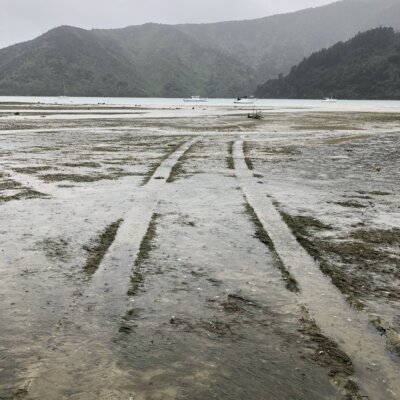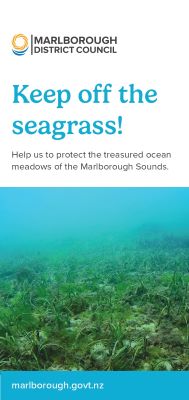Keep Off the Seagrass this Summer
This summer Marlborough District Council is diving in to highlight the importance of rimurehia/seagrass.
Coastal Scientist Jorgia McMillan, a member of the Nautical and Coastal team, is leading the summer education campaign with a new brochure, social media posts and awareness signs planned for specific sites around the Marlborough Sounds.
“Our message is simple – don’t walk or drive on seagrass – please keep off. This will help us to protect these treasured ocean meadows,” Jorgia said.

The local education campaign was launched at today’s Environment and Planning Committee in conjunction with a presentation from Dr Anna Berthelsen on the ‘seagrass restoration blueprint’ called Restore the Meadows which was recently released by Cawthron Institute, the result of three years’ work.
Cawthron Institute is working with businesses, government, industry, environmental groups and mana whenua to help restore seagrass to support biodiversity, improve water quality and mitigate climate change. The new rimurehia/seagrass blueprint offers a step-by-step guide to seed-based seagrass restoration for interested groups and organisations to help ensure as many people as possible can get involved.
Seagrass (Zostera muelleri) beds are a crucial part and positive indicator of a healthy estuary and intertidal area. Seagrass carries out several important ecosystem functions including providing habitat for fish, shellfish and other marine species.
The beds trap sediment and stabilise the ocean floor, as well as carrying out nutrient recycling which in turn improves coastal water quality. Seagrass acts as a buffer between land and sea and can minimise the effects of land-based activities on intertidal health.
“Sadly, this taonga species has disappeared from many parts of Marlborough and we need to look after what is left,” Jorgia said.
Rimurehia/seagrass is a marine flowering plant that can be found on intertidal flats and some subtidal areas throughout Marlborough. The campaign aims to educate the public and highlight the impact of damage caused by driving over seagrass beds when launching boats as well as anchoring and dredging on it.
“We want people to launch boats in areas with no rimurehia/seagrass to avoid damage. It’s also important to be mindful when anchoring or dredging as this can leave scars in the seagrass beds which can also hinder the movement of marine animals living amongst it,” Jorgia said.
“The Marlborough Sounds has experienced significant climate change impacts such as increased water temperatures in recent years. Seagrass beds act as an incredibly effective carbon sink, therefore providing a powerful nature-based solution to help tackle climate change impacts on our marine life. Land use practices and sedimentation can also have a major impact on seagrass,” she said.

The Marlborough coastal marine area includes over 65 estuaries and intertidal areas. The Coastal Science team at Marlborough District Council monitors seagrass across Te Hoiere/Pelorus and Tōtaranui/Queen Charlotte Sound as part of their ongoing estuary monitoring programme.
“The moana is important to all of us and we are very lucky in Marlborough to be one of the few places in Aotearoa that still has subtidal seagrass. We hope our summer campaign will educate people and make those out on the water this summer more aware of how to minimise their impact on the environment,” Jorgia said.
If you are interested to learn more or have seen damage to seagrass in your area, please contact Council’s Coastal Science team on coastal@marlborough.govt.nz





